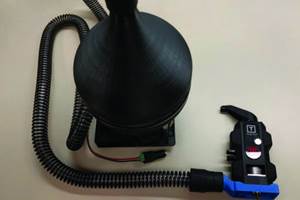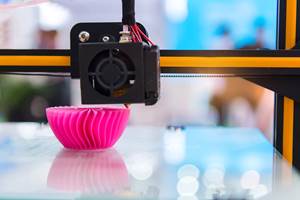Selective Laser Melting in Action
Four recent projects take on selective laser melting technology to improve part design, process speed, safety and flexibility.
Selective laser melting (SLM) is a versatile additive technology for working with metals, and its capabilities can help enable design improvements, speed production and provide benefits such as reduced weight in finished parts. Several recent projects illustrate applications for SLM:
1. Racing. In November 2014, European racing team Teto lost the World Title, which sent them on a mission to improve the performance of their race car’s engine. FIT West Corp., a division of FIT Technology Group located in Santa Clara, California, worked on designing a new cylinder head using additive manufacturing.
The company used selective laser melting from SLM Solutions to significantly increase the surface cooling area of the cylinder head and reduce vibration and weight. The result was a metal 3D-printed cylinder head with a weight reduction of 66 percent, from 5,095 gms to 1,755 gms, and a volume reduction from 1,887 cm3 down to 650 cm3. At the same time, the cylinder head’s surface area increased from 823 cm2 to 6,052 cm2 via a lattice framework of complex microstructures that has a much larger surface area compared to a hollow part. This allows for more efficient cooling, resulting in a better race car.
2. Unmanned aircraft. Another example of successful metals 3D printing is Aero Kinetics, the first company to file for FAA type certification for its latest generation multi-rotor vertical takeoff and land unmanned aircraft system (VTOL UAS), incorporating aluminum and titanium 3D-printed parts.
“The safety, speed and quality of SLM machines are well-suited to produce ultra-lightweight structural components for unmanned aircraft,” says Hulsey Smith, founder of Aero Kinetics. “When coupled with Aero Kinetics’ subject matter expertise in design for additive manufacturing, we reduced weight in critical structural components.”
3. Production parts for aerospace. Production parts for the aerospace industry have become a primary focus for metal 3D printing using SLM. Most recently Neff Capital Management LLC, a private equity firm based in Ft. Lauderdale, Florida, established a new company, called Sintavia LLC, to focus on the additive manufacturing of production parts for aerospace and defense OEMs around the world. The company is headquartered in Davie, Florida, and will produce parts based on the exacting quality control standards required by the aerospace and defense industry.
In addition to a serial production capability, the company will maintain a state-of-the-art metallurgical and metrology lab. Neff Capital’s funding of Sintavia includes a $10 million initial capital investment, to be rolled out in the coming 24 months, as the company grows and develops its capabilities. To support the production of highly complex metal parts, Sintavia will add three SLM 280HL dual-laser systems. With a 280 × 280 × 350-mm build envelope, the SLM 280HL model offers options to configure a single 400-W, dual (400 + 1000-W) or twin (400-W) lasers. The system’s open software controls, bi-directional recoating movement, and closed-loop metal powder handling help achieve the speed, safety and flexibility needed to optimize strict production parameters.
4. Ongoing research. A recent study funded by the U.S. Department of Energy Advanced Manufacturing Office demonstrated that aircraft weight can be reduced by 7 percent when additive manufacturing replaces conventional means of manufacturing. “Within 20 years, there will be a seismic shift in how we manufacture for the aerospace and defense industry,” says Brian Neff, managing partner of Neff Capital Management. “However, producers who do not understand or are incapable of producing parts with repetitive quality will not play a role in the OEM supply chain.”
Additionally, the Direct Manufacturing Research Center (DMRC) of the University of Paderborn, Germany, founded five years ago as a joint effort between academia and industry with the goal of advancing existing additive technologies into dependable production manufacturing, is currently working with stakeholders Boeing and Lufthansa Technik to develop parts using SLM Solutions’ AM machines. There are numerous goals for the project including reducing repair and overhaul costs, decreasing turnaround time of complex spare parts, increasing automation levels for spare parts production, reducing scrap and toxic chemicals used in the repair process, reducing part weight, and decreasing certification efforts for additively manufactured spare parts.
Related Content
NIOSH Publishes 3D Printing Safety Guide for Nonindustrial Settings
NIOSH has published a 3D printing safety guide for small businesses and other additive manufacturing users such as makerspace users, schools, libraries and small businesses.
Read MoreMultimaterial 3D Printing Enables Solid State Batteries
By combining different 3D printing processes and materials in a single layer, Sakuu’s Kavian platform can produce batteries for electric vehicles and other applications with twice the energy density and greater safety than traditional lithium-ion solutions.
Read MoreDurable, Waterproof 3D Printed Casts: The Cool Parts Show #58
Recovering from an injury with an ActivArmor cast means that patients can exercise, bathe and live life while they heal. We get a firsthand look at the solution in this episode of The Cool Parts Show.
Read MoreSLM Solutions, Assembrix Work to Ensure Secure Remote Printing
Following the integration of Assembrix VMS software into SLM Solutions’ machines, both companies are now working to ensure the enhanced safety and full protection of customers' intellectual property, which is made possible through the utilization of blockchain and encryption technologies.
Read MoreRead Next
Hybrid Additive Manufacturing Machine Tools Continue to Make Gains (Includes Video)
The hybrid machine tool is an idea that continues to advance. Two important developments of recent years expand the possibilities for this platform.
Read MoreAt General Atomics, Do Unmanned Aerial Systems Reveal the Future of Aircraft Manufacturing?
The maker of the Predator and SkyGuardian remote aircraft can implement additive manufacturing more rapidly and widely than the makers of other types of planes. The role of 3D printing in current and future UAS components hints at how far AM can go to save cost and time in aircraft production and design.
Read More3D Printing Brings Sustainability, Accessibility to Glass Manufacturing
Australian startup Maple Glass Printing has developed a process for extruding glass into artwork, lab implements and architectural elements. Along the way, the company has also found more efficient ways of recycling this material.
Read More





















